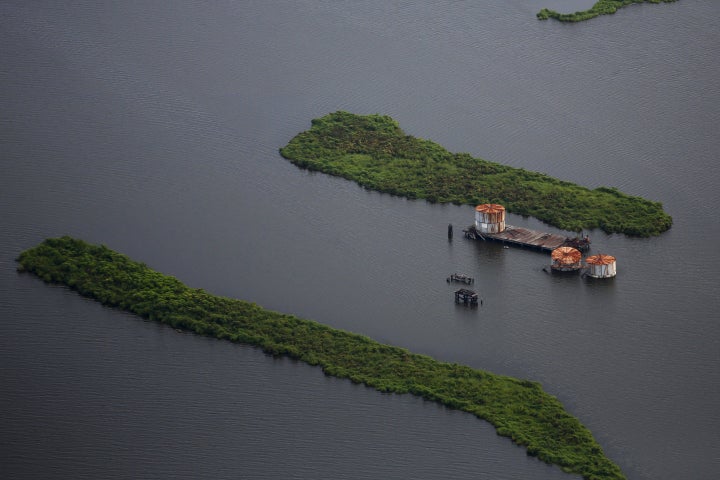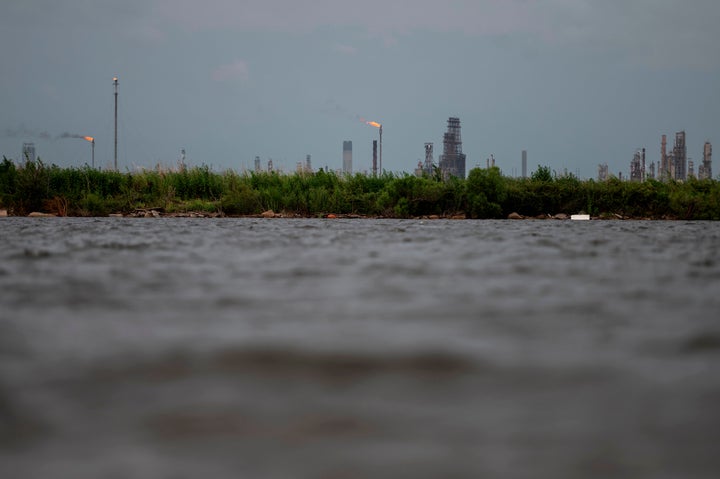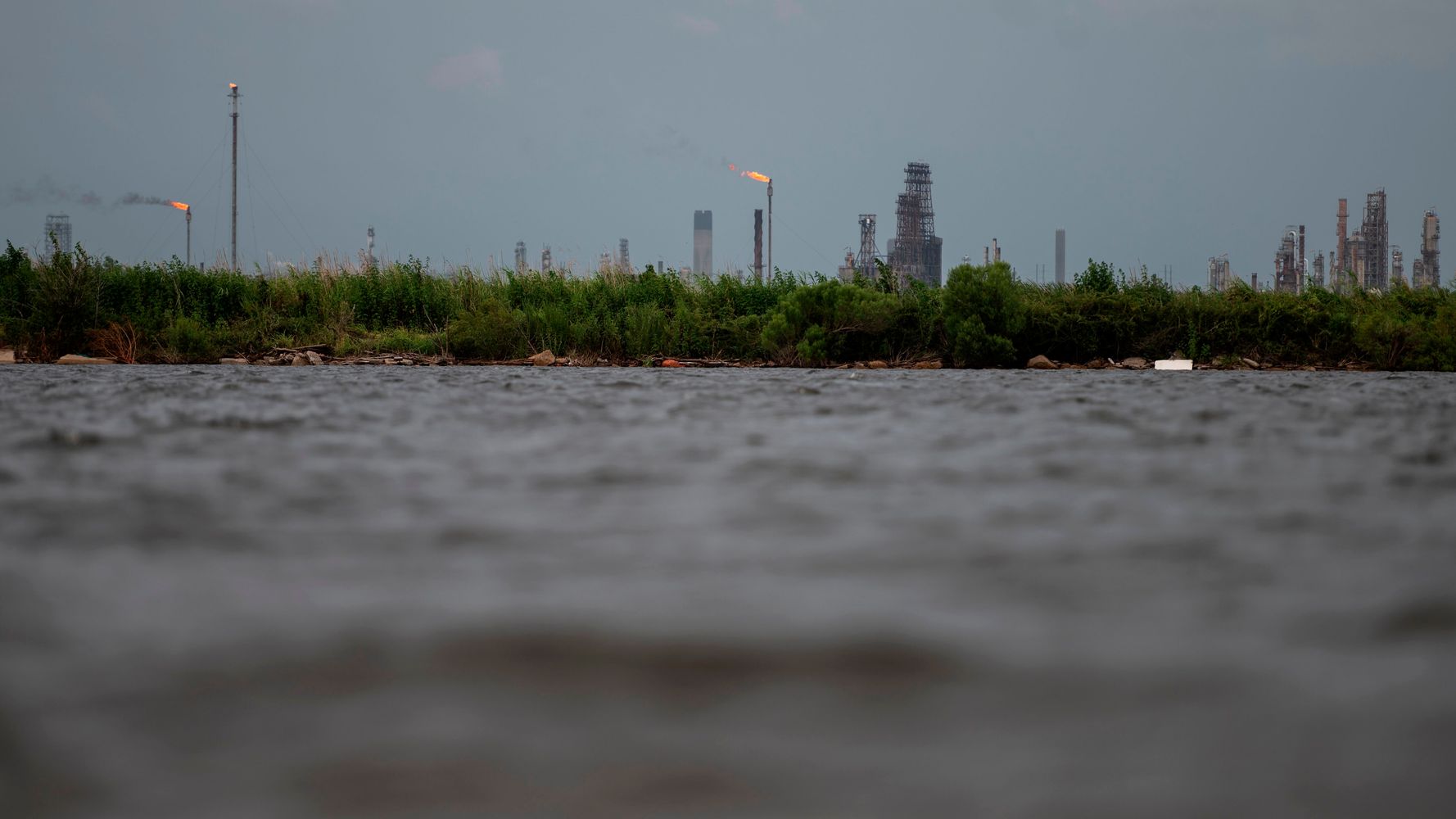[ad_1]
Hurricane Laura struck the Gulf Coast on Thursday morning, barreling into the country’s largest cluster of offshore drilling rigs, refineries and export facilities as one of the most powerful storms to ever make landfall in the U.S.
In theory, it could have forced a turning point for the oil and gas industry. The coronavirus pandemic sent demand for fuel plummeting to historic lows, triggering unprecedented financial losses for oil companies already drowning in debt. At the same time, the Category 4 storm offered yet another sign of the warming caused by fossil fuel emissions on top of a heat wave thawing the Arctic, floods deluging Bangladesh and China, and wildfires scorching the American West.
Yet analysts predicted oil and gas companies would make a steady recovery. Halting production in the Gulf will do little to reduce the supply of oil, gas and refined products because industry stored vast amounts of the stuff when demand plunged in March. During past hurricanes, companies spilled oil and chemicals with impunity, so fines and environmental citations look unlikely. And even if the damage proves too catastrophic to repair, proposed projects in Alaska and the Pacific Coast could replace the capacity on the Gulf.
“The industry ultimately will have to reckon with its environmental impact and risks to infrastructure,” said Anastacia Dialynas, an oil analyst at the energy research firm BloombergNEF.
“But, this time around,” she said, COVID-19, an oversupply on the market and a friendly administration in the White House is “probably delaying the reckoning.”
Echoes Of 2005
Fifteen years ago, back-to-back storms in the Gulf wreaked havoc on the U.S. oil and gas industry. Hurricanes Katrina and Rita smashed five offshore drilling rigs, destroyed 109 oil platforms, and damaged more than 400 pipelines.

Production fell by over a million barrels per day. In response, the industry increased investment in what was then a nascent drilling technology called hydraulic fracturing. Fracking, as it became known, transformed the U.S. into one of the world’s top exporters of oil and natural gas as friendly state and federal policies and virtually limitless Wall Street financing allowed companies to tap thousands of wells across West Texas, Appalachia and North Dakota.
“Katrina triggered the fracking revolution because prices spiked and you suddenly had enough incentive for these companies that had been experimenting with fracking to take it big time,” said Clark Williams-Derry, an analyst at the Institute for Energy Economics and Financial Analysis.
Today, fracking dominates U.S. production, meaning far less of the industry is affected by a storm in the Gulf.
“I don’t expect anything like that this time because offshore is a much smaller part of the U.S. oil picture,” Williams-Derry said. “It’s less of a big deal in terms of supply.”
Evading Blame
It was difficult to assess the extent of damage Thursday afternoon, even as the storm weakened over land. Louisiana State Police confirmed a chlorine fire at BioLab Inc., a spa and pool chemical manufacturer located near oil refineries.
“The natural gas and oil industry is closely monitoring Hurricane Laura and taking necessary precautions to safeguard employees and neighboring communities as well as minimize risk to critical infrastructure, including evacuating offshore production platforms and idling onshore facilities,” said Suzanne Lemieux, the emergency response manager at the American Petroleum Institute, the industry’s biggest lobby.
If there are spills, though, it’s unlikely companies will be held to account for them. Oil and gas firms have historically avoided punishment for oil and gas spills during storms.
The two big storms in 2005 triggered a combined 540 spills, spewing close to 11 million gallons of crude into Louisiana waters, roughly the same amount as the Exxon-Valdez tanker dumped when it ran aground in Alaska in 1989.
Under a 1990 law passed in response to that disaster, companies that spill oil are required to assess the damage with state and federal agencies and pay to restore the affected ecosystems. Yet not one of the 140 parties responsible for the spills in 2005 faced a fine or environmental citation, according to an investigation published last December by ProPublica and the two New Orleans newspapers The Advocate and The Times-Picayune.

“These companies say it’s an act of God or a force of nature whenever there’s a storm and they release thousands or millions of gallons,” said Anne Rolfes, director of the Louisiana Bucket Brigade, an environmental nonprofit. “They should win an Oscar for the role of victim in the time of storms.”
Other Horizons
Meanwhile, the industry is digging in. Some of the largest infrastructure expansions on the Gulf Coast over the past decade have been facilities to process and ship liquefied natural gas. Just last summer, gas giant Cheniere Energy announced plans to spend $3 billion on building a sixth unit on its LNG terminal in Cameron Parish, a district located directly in Laura’s path. In May, a New York-based investment group took over a proposed LNG terminal on Lake Charles, where some of the worst flooding from the storm is taking place. In July, a Texas energy company raised more money to build a planned LNG plant nearby.
Serious damage from Laura or any of the other powerful storms slated to form in the Atlantic this year could propel new terminals along the West Coast, Dialynas said. Already, California gas investor Sempra Energy is moving ahead with a new LNG export facility on Mexico’s west coast. Similar projects have been proposed in southwest Alaska and Oregon.
“The U.S. was attractive for a developing LNG market because we’re seen as a diversification away from the traditional suppliers, like Qatar,” Dialynas said. “Now you may see projects in other parts of the U.S. become attractive.”
Calling all HuffPost superfans!
Sign up for membership to become a founding member and help shape HuffPost’s next chapter
[ad_2]
Source


